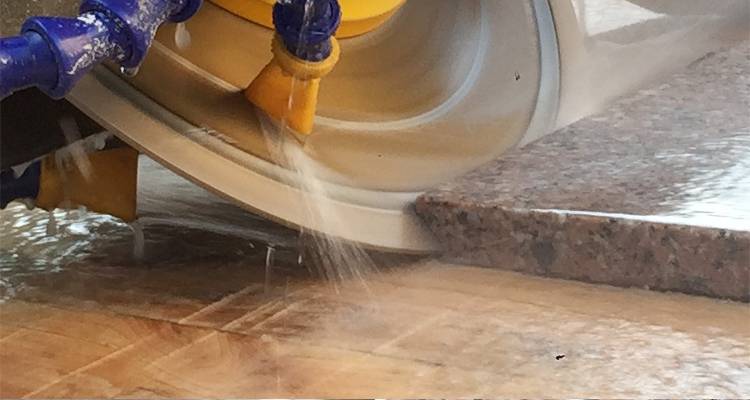Granite, known for its beauty and durability, is a popular material for countertops, flooring, and other decorative features in homes and businesses. However, cutting granite is a challenging task that requires the right tools and technique to achieve clean, precise results. One key decision when cutting granite is whether to use a wet or dry cutting method. In this article, we’ll explore the benefits and drawbacks of each method to help you decide which is best for your specific needs.
What is Wet Cutting and Dry Cutting?
Before we dive into the advantages and disadvantages, let’s define what wet and dry cutting mean in the context of granite.
- Wet Cutting: This method involves using a saw or cutting tool that has a water source to cool the blade as it cuts through the granite. Water is sprayed or continuously flows over the cutting surface to reduce heat buildup and minimize dust.
- Dry Cutting: In contrast, dry cutting involves no water. The cutting tool, usually equipped with a diamond blade, operates without coolant or lubrication. This method can create more dust and generate more heat compared to wet cutting.
Advantages of Wet Cutting Granite
1. Reduced Dust
Wet cutting significantly reduces the amount of dust produced during the cutting process. Since granite can release harmful silica dust when cut dry, wet cutting minimizes health risks, particularly for workers exposed to dust over time. This makes wet cutting a safer option, especially in confined spaces.
2. Cooler Blade Temperature
The water used in wet cutting helps keep the blade cool, preventing it from overheating. Overheating can cause the blade to dull faster or even warp, resulting in less efficient cutting. By cooling the blade, wet cutting extends its lifespan and ensures a cleaner, more precise cut.
3. Cleaner Cuts
Wet cutting often results in cleaner cuts with fewer chips along the edges. The cooling effect of the water helps reduce friction and prevents the blade from binding, allowing for a smoother, more precise finish.
4. Better for Larger Jobs
Wet cutting is ideal for large-scale projects like countertop fabrication, where prolonged cutting is necessary. The cooling effect helps maintain the consistency of the cutting process, especially when working with thick granite slabs.
Advantages of Dry Cutting Granite
1. Convenience and Portability
One of the major advantages of dry cutting is convenience. Since there is no need for a water supply or special equipment, dry cutting tools can be more portable. This is particularly useful for on-site jobs or if you’re working in areas where water access is limited or impractical.
2. Faster Setup and Execution
With dry cutting, there’s no need to worry about setting up water pumps, hoses, or drainage systems. This makes dry cutting quicker and simpler, especially for small-scale jobs or when you need to cut quickly.
3. No Need for Cleanup
While wet cutting may leave behind a mess of water and slurry, dry cutting produces less cleanup afterward. For smaller jobs or those where time and efficiency are key, this can be a significant advantage.
4. Suitability for Small Cuts
For smaller, more intricate cuts or detail work, dry cutting can be more practical. Without the extra weight and complexity of water systems, it’s easier to maneuver the cutting tool for precision tasks.

Which Method is Best for Cutting Granite?
The decision between wet or dry cutting ultimately depends on the scale of your project, your equipment, and your preferences. Here’s a quick breakdown:
- For Large Projects: If you’re cutting large slabs of granite, such as for countertops, wet cutting is generally the better choice. The water keeps the blade cool, reduces dust, and results in cleaner cuts, all of which are crucial for such detailed and high-visibility work.
- For Small or On-Site Jobs: If you’re working in a smaller space or need to cut granite in locations where water access is difficult, dry cutting might be more practical. It’s faster, more portable, and avoids the hassle of managing water during the cutting process.
- For Health and Safety Concerns: Wet cutting is preferable when health and safety are a concern. Since granite dust contains harmful silica, the wet method reduces airborne particles, making it safer for both you and others nearby.
Key Considerations for Both Methods
Blade Type: Both wet and dry cutting typically require a diamond blade, but make sure you’re using a blade that is specifically designed for granite. Wet cutting blades usually feature a segmented design to allow water to flow more efficiently, while dry cutting blades may have a continuous edge for smoother cuts.
Proper Ventilation: If you decide to go with dry cutting, ensure that the workspace is well-ventilated to minimize dust exposure. Using a vacuum attachment with your saw can also help reduce the spread of harmful dust.
Water Source and Cleanup: When cutting granite wet, ensure you have a reliable water source. Also, keep in mind that water runoff can create a mess, so you’ll need to have a plan for cleanup.
Conclusion: Wet or Dry Cutting?
In general, wet cutting is the preferred method for cutting granite due to its benefits in reducing dust, keeping blades cool, and providing cleaner cuts. It’s especially valuable for large, high-quality projects where precision is critical. On the other hand, dry cutting may be suitable for smaller, more portable jobs where convenience and speed are the priority.
Ultimately, the best choice depends on the specifics of your project, your available equipment, and safety concerns. By weighing the pros and cons of each method, you can make an informed decision that ensures a smooth, efficient granite cutting experience.
 WANLONG
WANLONG
